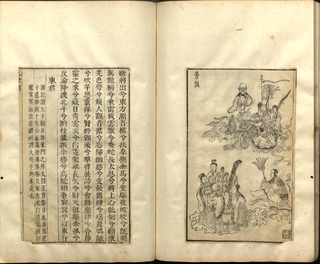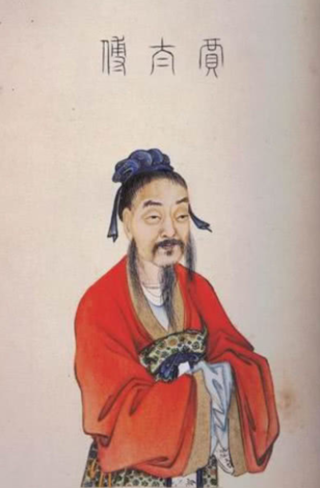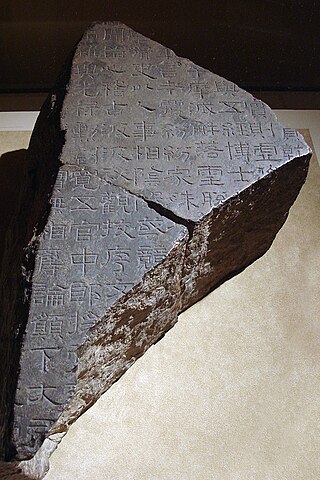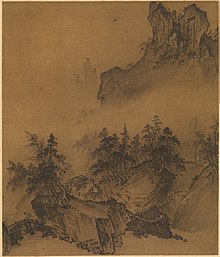
Dongting Lake is a large, shallow lake in northeastern Hunan Province, China. It is a flood basin of the Yangtze River, so its volume depends on the season. The provinces of Hubei and Hunan are named after their location relative to the lake: Hubei means "North of the Lake" and Hunan, "South of the Lake".

The Xiang River is the chief river of the Lake Dongting drainage system of the middle Yangtze, the largest river in Hunan Province, China. It is the 2nd largest tributary in terms of surface runoff, the 5th largest tributary by drainage area of the Yangtze tributaries. The river flows generally northeast through the provinces of Guangxi and Hunan, its tributaries reaching into Jiangxi and Guangdong.

Qu Yuan was a Chinese poet and aristocrat in the State of Chu during the Warring States period. He is known for his patriotism and contributions to classical poetry and verses, especially through the poems of the Chu Ci anthology : a volume of poems attributed to or considered to be inspired by his verse writing. Together with the Shi Jing, the Chu Ci is one of the two greatest collections of ancient Chinese verse. He is also remembered in connection to the supposed origin of the Dragon Boat Festival.

The Chu ci, variously translated as Verses of Chu, Songs of Chu, or Elegies of Chu, is an ancient anthology of Chinese poetry including works traditionally attributed mainly to Qu Yuan and Song Yu from the Warring States period, and also a large number of works composed several centuries later, during the Han dynasty. The traditional version of the Chu ci contains 17 major sections, anthologized with its current contents by Wang Yi, a 2nd-century AD librarian who served under Emperor Shun of Han. The early Classical Chinese poetry is mainly known through the two anthologies the Chu ci and the Shi jing.

"Li Sao" is an ancient Chinese poem from the anthology Chuci traditionally attributed to Qu Yuan. Li Sao dates from the 3rd century BCE, during the Chinese Warring States period.

Jiu Ge, or Nine Songs, is an ancient set of poems. Together, these poems constitute one of the 17 sections of the poetry anthology which was published under the title of the Chuci. Despite the "Nine", in the title, the number of these poetic pieces actually consists of eleven separate songs, or elegies. This set of verses seems to be part of some rituals of the Yangzi River valley area involving the invocation of divine beings and seeking their blessings by means of a process of courtship. Though the poetry consists of lyrics written for a performance, the lack of indications of who is supposed to be singing at any one time or whether some of the lines represent lines for a chorus makes an accurate reconstruction impossible. Nonetheless there are internal textual clues, for example indicating the use of costumes for the performers, and an extensive orchestra.
Song Yu was a Chinese poet from the late Warring States period, and is known as the traditional author of a number of poems in the Verses of Chu . Among the Verses of Chu poems usually attributed to Song Yu are those in the Jiu Bian section. Also credited to Song Yu, somewhat improbably, are several fu collected in the 6th century literary anthology Wen Xuan.

Jia Yi was a Chinese essayist, poet and politician of the Western Han dynasty, best known as one of the earliest known writers of fu rhapsody and for his essay "Disquisition Finding Fault with Qin", which criticises the Qin dynasty and describes Jia's opinions on the reasons for its collapse. In particular, he is famous for his two fu, On the Owl (鵩鳥賦) and his Lament for Qu Yuan (吊屈原賦). He is also the author of the treatise Xinshu (新書), containing political and educational insights.

The Eight Views of Xiaoxiang are scenes of the Xiaoxiang region, in what is now modern Hunan Province, China, that were the subject of the poems and depicted in well-known drawings and paintings from the time of the Song Dynasty. The Eight Views of Xiaoxiang can refer either to various sets of paintings which have been done on this theme, the various verse series on the same theme, or to combinations of both. The Xiaoxiang theme is part of a long poetic and artistic legacy.
Song poetry refers to Classical Chinese poetry of or typical of the Song dynasty of China, established by the Zhao family in China in 960 and lasted until 1279.

Xiaoxiang, also transliterated XiaoXiang, Hsiao Hsiang, and Chiu Chiang, in some older sources, refers to the "lakes and rivers" region in south-central China south of the middle-reaches of the Yangtze River and corresponding, more or less, with Hunan province. Xiaoxiang is less a precise geographic entity than a concept. Xiaoxiang is used in the genre of Xiaoxiang poetry of Classical Chinese poetry and in literature for symbolic purposes, in part because this was a significant area, which at least through the Song dynastic era China was still considered a wild place full of malaria, barbarians, and wild beasts. Indeed, for much of early Chinese history, this area belonged not to China, but to the independent state of Chu. Beginning at least with Qu Yuan, in the third century BCE, this region came to symbolically represent the unjust exile of a talented minister or government official by an unappreciative king or emperor.

Han poetry as a style of poetry resulted in significant poems which are still preserved today, and whose origins are associated with the Han dynasty era of China, 206 BC – 220 AD, including the Wang Mang interregnum. The final years at the end of the Han era often receive special handling for purposes of literary analysis because, among other things, the poetry and culture of this period is less than typical of the Han period, and has important characteristics of its own, or it shares literary aspects with the subsequent Three Kingdoms period. This poetry reflects one of the poetry world's more important flowerings, as well as being a special period in Classical Chinese poetry, particularly in regard to the development of the quasipoetic fu; the activities of the Music Bureau in connection with the collection of popular ballads and the resultant development of what would eventually become known as the yuefu, or as the rhapsodic formal style; and, finally, towards the end of the Han dynasty, the development of a new style of shi poetry, as the later development of the yuehfu into regular, fixed-line length forms makes it difficult to distinguish in form from the shi form of poetic verse, and at what point specific poems are classified as one or the other is somewhat arbitrary. Another important poetic contribution from the Han era is the compilation of the Chuci anthology, which contains some of the oldest and most important poetic verses to be preserved from ancient China, as well as the transmission of the Shijing anthology.

The History of fu poetry covers the beginnings of the Chinese literary genre of fu. The term fu describes literary works which have certain characteristics of their own. English lacks an equivalent native term. Sometimes called "rhapsodies", sometimes called "rhyme-prose", fu are characterized by qualities of both poetry and prose: both are obligatory. The fu form of literary work is a treatment in a poetic manner, wherein some topic of interest, such as an exotic object, a profound feeling, or an encyclopedic subject is described and rhapsodized upon, in exhaustive detail and various angles of view. And, for a piece to be truly considered to be within the fu genre, it must follow the rules of this form, in terms of structure, meter, and so on.
Wang Yi, courtesy name Shushi, was a Chinese anthologist, librarian, and poet during the Eastern Han dynasty who was employed in the Imperial Library by the Later Han emperor Shun Di. Wang Yi is known for his work on the poetry anthology Chu Ci. Although with varying reliability, his commentaries on this work are a main source of information regarding some of its often obscure textual references.
"Nine Changes," also known as "Nine Variations,""Chiu pien" or "Jiu Bian" is one of the 17 poems in the ancient Chinese poetry collection Chu ci, also known as The Songs of the South, or The Verses of Chu. Along with Shi Jing, Chu ci is one of the two essential Classical Chinese anthologies of poetry. The authorship, date, division, title significance, and composition intention of "Nine Changes" are controversial. However, it is still vital in the development process of Chinese poetry. As a poem in Chu ci, "Nine Changes" is written in a new style: "Sao Style," which allows each line to contain a good deal of narrative. Moreover, starting from "Nine Changes," "be grieved by autumn" (悲秋) has been a motif of traditional Chinese literature.
Wang Bao, courtesy name Ziyuan (子淵), was a Chinese poet during the Western Han dynasty. He was well versed in the Classical Chinese poetry tradition. He was involved in the Chu Ci poetry revival which took place in the second part of Emperor Xuan's reign, and which led to the creation of poetry that would eventually form part of the early poetry anthology by the same name, compiled by Wang Yi. Chu Ci means "literature of Chu", Chu being the area of a former independent kingdom, located in what was from the viewpoint of the Han dynasty the south of China. Wang Bao is particularly known today as the author of the Chu Ci section "Nine Regrets". His poetry was not as famous as "Li Sao" or "Heavenly Questions". Indeed, sometimes Qu Yuan has been credited as the author of his poetry. Wang Bao's works were included in one of the two major early anthologies of Chinese poetry which has helped to secure Wang Bao's legacy as a poet and author. Wang Bao became famous during the reign of Han dynasty emperor Emperor Xuan, and he attended the courts of the emperor and the prince, his presumptive heir.

Kui Prefecture, Kuizhou Circuit, or Kuizhou was initially established in 619 CE, as a renaming of the existing Xin Prefecture. Kuizhou was an important area from the beginning and through the end of the Tang dynasty of China, when it was alternatively part of several of the Circuits which made up typical large scale political structural organizations of the Tang era. Kuizhou continued as a political entity through the end of the Song dynasty, during which it was of Provincial level, a typical large scale political organization of Song era. Kui Prefecture was located in what is now eastern Chongqing. During the Song dynasty, Kuizhou's capital was located in what is now Fengjie County, Chongqing, and the extent of the province was to what today includes Chongqing, eastern Sichuan, and Guizhou. Part of the importance of Kuizhou was related to its prominent location along the Yangzi River. Kui was also known for its spectacular scenerary, and being a location in which exiled poets wrote their laments.

Geese are an important motif in Chinese poetry. Examples of goose imagery have an important place in Chinese poetry ranging from the Shijing and the Chu Ci poets through the poets of Han poetry and later poets of Tang poetry such as Li Bai, Wang Wei, Du Fu, and the Xiaoxiang poetry, especially in the poetry of the Song dynastic era. Various poetic concepts could be communicated by the inclusion of the imagery of geese in a poem, and the understanding of allusions to a goose or geese can help provide key insights into the poems of Classical Chinese poetry. Chinese sources typically distinguish between two types of geese, the domestic goose, and the wild goose: of the two, the wild goose is the more important for poetry, whether as significant of migratory seasonal change, or as "bearing a message of love from afar", by persons separated by a great distance, or as the "lone goose", bereft of both mate and flock.














